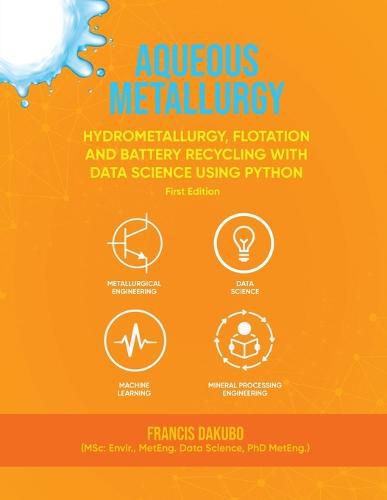Readings Newsletter
Become a Readings Member to make your shopping experience even easier.
Sign in or sign up for free!
You’re not far away from qualifying for FREE standard shipping within Australia
You’ve qualified for FREE standard shipping within Australia
The cart is loading…






This title is printed to order. This book may have been self-published. If so, we cannot guarantee the quality of the content. In the main most books will have gone through the editing process however some may not. We therefore suggest that you be aware of this before ordering this book. If in doubt check either the author or publisher’s details as we are unable to accept any returns unless they are faulty. Please contact us if you have any questions.
This book, titled aqueous metallurgy, flotation, and battery recycling with Python, is written for the practicing metallurgical, chemical, environmental, geochemical, mining, microbiologist, and geological engineering students and scientists who want to learn the theory behind most of the processes in aqueous metallurgy. This book is also helpful for engineering students and scientists interested in learning the practical use of modern software such as Python in solving problems. This book covers hydrometallurgy, interfacial phenomena, and flotation; additional topics covered include mixing theory, battery recycling, and an introduction to data science using Python and SageMath.
As we advance into the future, our demand for new minerals and metals increases for use in making energy and building faster computers and machines.
It is essential to ensure that our students and workforce of the feature are equipped with all the engineering tools to deliver their services optimally.
This aqueous metallurgy book is written to equip practicing engineers and students with modern metallurgical and computational skills in Python to operate with the proper knowledge and computer skill for optimal output.
Managers, Engineers, Scientists, and other technology in the metallurgical, chemical, environmental, and mining industries, from the laboratory to the plant teams, will benefit from the information provided in this book. This book on aqueous metallurgy highlights the theory and some practical knowledge required in all mineral and metallurgical industries. This book could be used alone or in conjunction with my metallurgical testing and assaying book, which contains a step-by-step approach to conducting practical experiments in the laboratory and pilot plant.
$9.00 standard shipping within Australia
FREE standard shipping within Australia for orders over $100.00
Express & International shipping calculated at checkout
This title is printed to order. This book may have been self-published. If so, we cannot guarantee the quality of the content. In the main most books will have gone through the editing process however some may not. We therefore suggest that you be aware of this before ordering this book. If in doubt check either the author or publisher’s details as we are unable to accept any returns unless they are faulty. Please contact us if you have any questions.
This book, titled aqueous metallurgy, flotation, and battery recycling with Python, is written for the practicing metallurgical, chemical, environmental, geochemical, mining, microbiologist, and geological engineering students and scientists who want to learn the theory behind most of the processes in aqueous metallurgy. This book is also helpful for engineering students and scientists interested in learning the practical use of modern software such as Python in solving problems. This book covers hydrometallurgy, interfacial phenomena, and flotation; additional topics covered include mixing theory, battery recycling, and an introduction to data science using Python and SageMath.
As we advance into the future, our demand for new minerals and metals increases for use in making energy and building faster computers and machines.
It is essential to ensure that our students and workforce of the feature are equipped with all the engineering tools to deliver their services optimally.
This aqueous metallurgy book is written to equip practicing engineers and students with modern metallurgical and computational skills in Python to operate with the proper knowledge and computer skill for optimal output.
Managers, Engineers, Scientists, and other technology in the metallurgical, chemical, environmental, and mining industries, from the laboratory to the plant teams, will benefit from the information provided in this book. This book on aqueous metallurgy highlights the theory and some practical knowledge required in all mineral and metallurgical industries. This book could be used alone or in conjunction with my metallurgical testing and assaying book, which contains a step-by-step approach to conducting practical experiments in the laboratory and pilot plant.